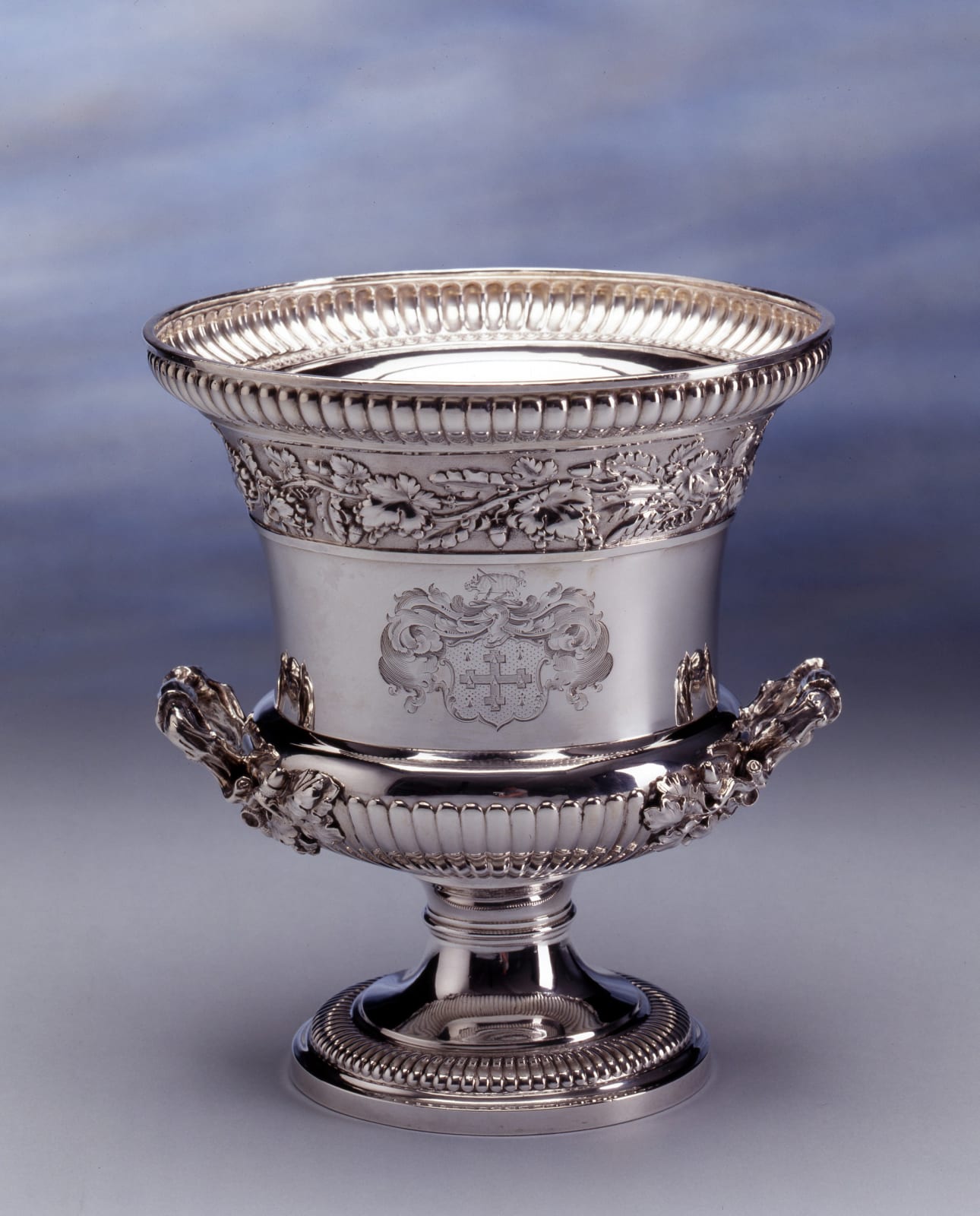Paul Storr English, 1771-1844
An extremely fine Regency sterling silver wine cooler by Paul Storr (1771-1844) bearing a coat of arms
London, dated 1815
Fully hallmarked. Height 27 cm.
Paul Storr was undoubtedly the greatest British silversmith of the Regency period. His range of wares was wide, from cutlery and teapots to wine coolers and huge presentation pieces. His work was of the highest standard and even the smallest items were made from heavy gauge silver. He was apprenticed to a Swedish born silversmith, Andrew Fogelberg for six years. In 1792 he went into partnership with William Frisbee but after three years they parted and Storr was soon established as a major independent silversmith. Among early important commissions he made a gold font for the Duke of Portland, 1797. Two years later he made the famous "Battle of the Nile Cup" which was presented to Lord Nelson (now in the National Maritime Museum, London). Philip Rundell was very keen for Storr to join his firm and finally persuaded him to do so in 1807 though Storr retained his mark for independent work.
Many of his best pieces were made during the early years of the nineteenth century. By this time the fashion for the Adam style was waning so Storr's 'massive' forms and good ornament made a refreshing change and set a precedent for others. He took his main inspiration from classical Greece but at times was also inspired by Rococo design. Many of his larger presentation pieces from this period were designed by the sculptor, John Flaxman, notably the "Theocritus Cup" of 1812-13 (now Royal Collection, Windsor). By 1819 Storr could no longer put up with Rundell's temperament so he left the Crown Jewellers to work in partnership with John Mortimer with whom he continued until his retirement in 1838.
HUNT AND ROSKELL, ENGLISH FOUNDED IN 1819 BY PAUL STORR (I771- 1844).
A visitor to Hunt and Roskell s workshop in Harrison Street, London described the firm "ranking as the very highest of the class-not alone for the beauty of their workmanship, but for the eiquisitely artistic taste, as well as for the consummate care and thoughtfulness displayed in their designs". (Trades and Manufactories of Great Britain. 1865). For most of the Nineteenth Century the firm ranked as London’s leading silver and jewellery manufacturer, rivalled only by R. and S. Garrard and Co. and C. F. Hancock Hunt and Roskell produced high class domestic silver but like Garrard's specialised in massive sculptural trophies, centre pieces and presentation plate Hunt and Roskell was founded by Paul Storr. who on dissolving his partnership with Rundell and Bridge. 1819 set up a workshop in Harrison Street, assisted by his nephew John Samuel Hunt (d 1865).
In 1822 Storr entered partnership with Joho Mortimer trading under the name of Storr and Mortimer (1S22-38I The latter ran the retail business from Bond Street while Storr continued to look after the manufacturing side However by 1826. overstocking on Mortimer s behalf took the firm to the edge of bankruptcy, it was saved by a £5.000 investment from J. S. Hunt. The latter became a partner though the firm continued in the name of Storr and Mortimer On Storr’s retirement John Samuel s son, John Hunt (c 1811-1879) joined the partnership and the firm was renamed Mortimer and Hunt (1839-13). Mortimer retired in 1813 whereupon the Hunts look Robert Roskell of Liverpool (d 1888) and C. F. Hancock (who left in 1819) into partnership and were known as Hunt and Roskell, 1813-97. After John Hunts death. 1879 the firm was run by his son, John Mortimer Hunt. Robert Roskell and his son Allan In 1889 Alfred Benson purchased the business, it was made a Limited Company in 1897 and known as Hunt and Roskell Ltd. until c. 1965.
In many ways Hunt and Roskell were similar to Rundell's , firstly in their use of naturalistic ornament and secondly in their creation of elaborate sculptural silver. During his association with Rundell’s Storr bad executed designs in the neo-classic rococo and baroque with equal fluency Hunt and Roskell exemplified the increasing desire for naturalistic ornament derived from the same source - from the classic acanthus to the floral rococo Following the dissolution of Run- dell's in 1842. Roskells and Garrard s became the most important manufacturers of sculptural and presentation silver. Such pieces relied upon a high degree of figurative realism for their success, to achieve this, modellers at Hunt and Roskell worked directly from the nude The firm employed some of the finest modellers and designers, notably from 1843 the French metal worker, Antoine Vechte (1800 - 1868 ) who designed the Titan Vase (Goldsmith s Co , London), displayed at the Great Exhibition, 1851 Among the firm's earliest designers was Edward Hodges Baily (1788-1867), who as assistant to John Flaxman (1755-1826) had worked for Storr and Co and for Rundell's. Frank Howard (1805-66) pupil and assistant to the court painter. Sir Thomas Lawrence (1769-1839) subsequently joined Storr and Mortimer While another portraitist. Sir George Rayler (1792-1871) designed Hunt and Roskells Montifiore Testimonial. 1842 The firm contributed important displays of silver and jewellery at a number of international exhibitions. notably the Great Exhibition. 1851, the International of 1862. Pans. 1867. London, 1872 and the Health Exhibition of 1884.
